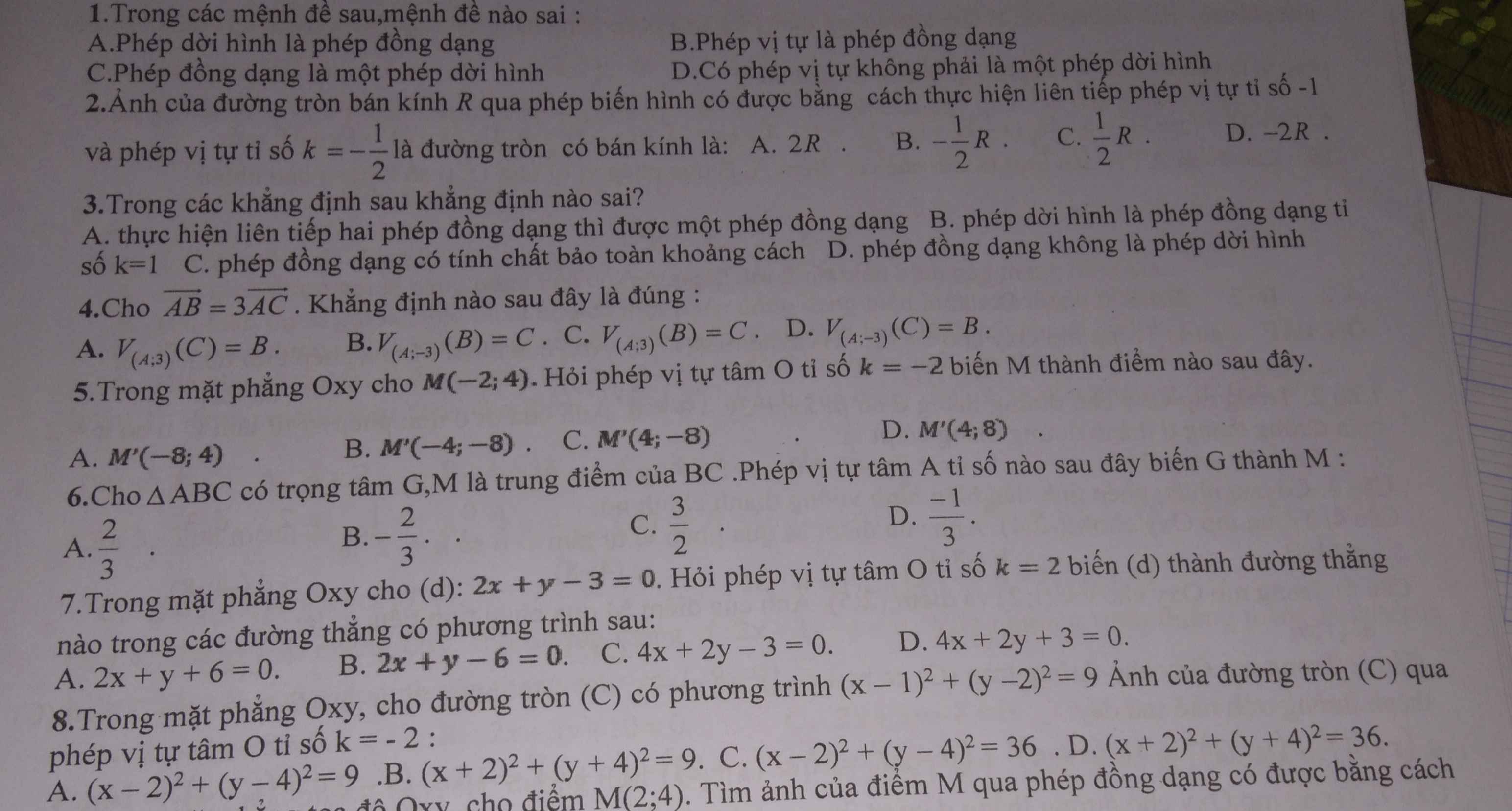
Hãy nhập câu hỏi của bạn vào đây, nếu là tài khoản VIP, bạn sẽ được ưu tiên trả lời.


\(y=\dfrac{sinx+2cosx+1}{sinx+cosx+2}\)
Thấy : \(sinx+cosx+2\ge-1-1+2=0\) . " = " ko xảy ra nên : \(sinx+cosx+2>0\)
Suy ra : \(\left(y-1\right)sinx+\left(y-2\right)cosx=1-2y\) (*)
(*) có no \(\Leftrightarrow\left(y-1\right)^2+\left(y-2\right)^2\ge\left(1-2y\right)^2\Leftrightarrow2y^2-6y+5\ge4y^2-4y+1\Leftrightarrow-2y^2-2y+4\ge0\)
\(\Leftrightarrow-y^2-y+2\ge0\) \(\Leftrightarrow-2\le y\le1\)
Suy ra : Max y = 1 . Chọn B
21 : \(cosx-\sqrt{3}sinx=0\)
cos x = 0 thay vào : sin x = 0 ( L )
cos x khác 0 \(\Leftrightarrow x\ne\dfrac{\pi}{2}+k\pi\left(k\in Z\right)\); ta có : \(1-\sqrt{3}tanx=0\Leftrightarrow tanx=\dfrac{1}{\sqrt{3}}\Leftrightarrow x=\dfrac{\pi}{6}+k\pi\left(k\in Z\right)\)

49.
\(\Leftrightarrow m.sin2x+2\left(cos2x+1\right)=m+5\)
\(\Leftrightarrow m.sin2x+2cos2x=m+3\)
Pt có nghiệm khi:
\(m^2+2^2\ge\left(m+3\right)^2\)
\(\Leftrightarrow6m\le-5\Rightarrow m\le-\dfrac{5}{6}\)
\(\Rightarrow m=\left\{-3;-2;-1\right\}\)
50.
\(\Leftrightarrow m.2sin^2x+4sinx.cosx+3m.2cos^2x=2\)
\(\Leftrightarrow m\left(1-cos2x\right)+2sin2x+3m\left(1+cos2x\right)=2\)
\(\Leftrightarrow m.cos2x+sin2x=1-2m\)
Pt có nghiệm khi:
\(m^2+1\ge\left(1-2m\right)^2\Leftrightarrow3m^2-4m\le0\)
\(\Rightarrow m\in\left[0;\dfrac{4}{3}\right]\)
51.
ĐKXĐ: \(x\ne k\pi\)
\(\dfrac{5-4cosx}{sinx}=\dfrac{6tana}{1+tan^2a}\)
\(\Leftrightarrow\dfrac{5-4cosx}{sinx}=\dfrac{6sina}{cosa}.cos^2a=3sin2a\)
\(\Leftrightarrow5-4cosx=3sin2a.sinx\)
\(\Leftrightarrow3sin2a.sinx+4cosx=5\)
Pt có nghiệm khi:
\(\left(3sin2a\right)^2+4^2\ge5^2\)
\(\Leftrightarrow sin^22a\ge1\)
\(\Leftrightarrow sin^22a=1\Leftrightarrow cos2a=0\)
\(\Leftrightarrow2a=\dfrac{\pi}{2}+k\pi\Rightarrow a=\dfrac{\pi}{4}+\dfrac{k\pi}{2}\)
\(\Rightarrow a=\left\{\dfrac{\pi}{4};\dfrac{3\pi}{4};\dfrac{5\pi}{4};\dfrac{7\pi}{4}\right\}\)
Em tự cộng và chọn kết quả nhé

13.
\(y=1+sin2x-\left(1-sin^22x\right)=sin^22x+sin2x\)
\(y=\left(sin2x+\dfrac{1}{2}\right)^2-\dfrac{1}{4}\ge-\dfrac{1}{4}\)
\(\left\{{}\begin{matrix}sin^22x\le1\\sin2x\le1\end{matrix}\right.\) \(\Rightarrow y\le1+1=2\)
\(\Rightarrow\left\{{}\begin{matrix}a=-\dfrac{1}{4}\\b=2\end{matrix}\right.\)
\(\Rightarrow4a+b=1\)
14.
\(\Leftrightarrow\left[{}\begin{matrix}2x-\dfrac{\pi}{4}=x+\dfrac{3\pi}{4}+k2\pi\\2x-\dfrac{\pi}{4}=\dfrac{\pi}{4}-x+k2\pi\end{matrix}\right.\)
\(\Leftrightarrow\left[{}\begin{matrix}x=\pi+k2\pi\\x=\dfrac{\pi}{6}+\dfrac{k2\pi}{3}\end{matrix}\right.\)
\(\Rightarrow x=\left\{\dfrac{\pi}{6};\dfrac{5\pi}{6}\right\}\)
\(\Rightarrow\dfrac{\pi}{6}+\dfrac{5\pi}{6}=\pi\)
15.
\(3cosx+2cos^2x-1-cos3x+1=cosx-cos3x\)
\(\Leftrightarrow cos^2x+cosx=0\)
\(\Leftrightarrow\left[{}\begin{matrix}cosx=0\\cosx=-1\end{matrix}\right.\)
\(\Leftrightarrow\left[{}\begin{matrix}x=\dfrac{\pi}{2}+k\pi\\x=\pi+k2\pi\end{matrix}\right.\)
\(\Rightarrow\) Nghiệm lớn nhất \(x=\dfrac{3\pi}{2}\)
\(sin\left(\dfrac{3\pi}{2}-\dfrac{\pi}{4}\right)=-\dfrac{\sqrt{2}}{2}\)
16.
\(cos\left(2x+\dfrac{2\pi}{3}\right)+4cos\left(\dfrac{\pi}{6}-x\right)=\dfrac{5}{2}\)
\(\Leftrightarrow cos\left[\pi-2\left(\dfrac{\pi}{6}-x\right)\right]+4cos\left(\dfrac{\pi}{6}-x\right)=\dfrac{5}{2}\)
\(\Leftrightarrow-cos\left[2\left(\dfrac{\pi}{6}-x\right)\right]+4cos\left(\dfrac{\pi}{6}-x\right)=\dfrac{5}{2}\)
\(\Leftrightarrow1-2cos^2\left(\dfrac{\pi}{6}-x\right)+4cos\left(\dfrac{\pi}{6}-x\right)=\dfrac{5}{2}\)
\(\Leftrightarrow1-2t^2+4t=\dfrac{5}{2}\Leftrightarrow4t^2-8t+3=0\)

17.
\(sin2x=sinx\Rightarrow\left\{{}\begin{matrix}2x=x+k2\pi\\2x=\pi-x+k2\pi\end{matrix}\right.\)
\(\Leftrightarrow\left\{{}\begin{matrix}x=k2\pi\\x=\dfrac{\pi}{3}+\dfrac{k2\pi}{3}\end{matrix}\right.\)
Nghiệm dương nhỏ nhất: \(x=\dfrac{\pi}{3}\)
18.
\(-1\le sin3x\le1\Rightarrow-1\le y\le4\)
\(miny=-1\) ; \(maxy=4\)
18 ver 1
Câu này trắc nghiệm điển hình, chỉ thay \(x=40^0\) vào 4 đáp án để thử, ko ai tự luận nó cả
19.
ĐKXĐ:
\(cos\left(2x-\dfrac{\pi}{3}\right)\ne0\)
\(\Leftrightarrow2x-\dfrac{\pi}{3}\ne\dfrac{\pi}{2}+k\pi\)
\(\Leftrightarrow x\ne\dfrac{5\pi}{12}+\dfrac{k\pi}{2}\)

27.
\(cos\left(\dfrac{x}{2}+15^0\right)=sinx\)
\(\Leftrightarrow cos\left(\dfrac{x}{2}+15^0\right)=cos\left(90^0-x\right)\)
\(\Leftrightarrow\left[{}\begin{matrix}\dfrac{x}{2}+15^0=90^0-x+k360^0\\\dfrac{x}{2}+15^0=x-90^0+k360^0\end{matrix}\right.\)
\(\Leftrightarrow\left[{}\begin{matrix}x=50^0+k240^0\\x=210^0+k720^0\end{matrix}\right.\)
Với \(k=1\Rightarrow x=50^0+240^0=290^0\)
28.
\(sin\left(x-\dfrac{\pi}{4}\right)\ne0\)
\(\Leftrightarrow x-\dfrac{\pi}{4}\ne k\pi\)
\(\Leftrightarrow x\ne\dfrac{\pi}{4}+k\pi\)
29.
\(\Leftrightarrow cos\left(x+\dfrac{\pi}{3}\right)=\dfrac{\sqrt{2}}{2}\)
\(\Leftrightarrow\left[{}\begin{matrix}x+\dfrac{\pi}{3}=\dfrac{\pi}{4}+k2\pi\\x+\dfrac{\pi}{3}=-\dfrac{\pi}{4}+k2\pi\end{matrix}\right.\)
\(\Leftrightarrow\left[{}\begin{matrix}x=-\dfrac{\pi}{12}+k2\pi\\x=-\dfrac{7\pi}{12}+k2\pi\end{matrix}\right.\)
\(\Rightarrow x=\left\{\dfrac{17\pi}{12};\dfrac{23\pi}{12}\right\}\)
30.
Pt \(2sinx+3cosx=1\) có \(2^2+3^2>1^2\) nên có nghiệm

40.
\(\sqrt{3}tanx-1=0\)
\(\Leftrightarrow tanx=\dfrac{1}{\sqrt{3}}\)
\(\Rightarrow x=30^0+k180^0\)
41.
Từ đồ thị ta thấy hàm đồng biến trên \(\left(-\dfrac{\pi}{2};0\right)\) (đồ thị hàm số chỉ có xu hướng đi lên chứ không có đoạn đi xuống trên toàn miền)
42.
\(\Leftrightarrow1-cos2x-2sin2x+2\left(1+cos2x\right)=1\)
\(\Leftrightarrow cos2x-2sin2x=-2\)
43.
\(cos3x=1\Leftrightarrow4cos^3x-3cosx-1=0\)
\(\Leftrightarrow\left(cosx-1\right)\left(2cosx+1\right)^2=0\Leftrightarrow\left[{}\begin{matrix}cosx=1\\cosx=-\dfrac{1}{2}\end{matrix}\right.\)
\(cos2x=-\dfrac{1}{2}\Leftrightarrow2cos^2x-1=-\dfrac{1}{2}\)
\(\Leftrightarrow cos^2x=\dfrac{1}{4}\Rightarrow\left[{}\begin{matrix}cosx=\dfrac{1}{2}\\cosx=-\dfrac{1}{2}\end{matrix}\right.\)
So sánh 2 pt trên ta thấy chúng có nghiệm chung \(cosx=-\dfrac{1}{2}\)
\(\Leftrightarrow x=\pm\dfrac{2\pi}{3}+k2\pi\)


8a.
\(\lim\limits_{x\rightarrow1^+}f\left(x\right)=\lim\limits_{x\rightarrow1^+}\left(3x^2-5x+1\right)=3-5+1=-1\)
\(\lim\limits_{x\rightarrow1^-}f\left(x\right)=\lim\limits_{x\rightarrow1^-}\left(-3x+2\right)=-3+2=-1\)
\(\Rightarrow\lim\limits_{x\rightarrow1^+}f\left(x\right)=\lim\limits_{x\rightarrow1^-}f\left(x\right)\Rightarrow\) hàm có giới hạn tại \(x=1\)
Đồng thời \(\lim\limits_{x\rightarrow1}f\left(x\right)=-1\)
b.
\(\lim\limits_{x\rightarrow2^+}f\left(x\right)=\lim\limits_{x\rightarrow2^+}\dfrac{x^3-8}{x-2}=\lim\limits_{x\rightarrow2^+}\dfrac{\left(x-2\right)\left(x^2+2x+4\right)}{x-2}\)
\(=\lim\limits_{x\rightarrow2^+}\left(x^2+2x+4\right)=12\)
\(\lim\limits_{x\rightarrow2^-}f\left(x\right)=\lim\limits_{x\rightarrow2^-}\left(2x+1\right)=5\)
\(\Rightarrow\lim\limits_{x\rightarrow2^+}f\left(x\right)\ne\lim\limits_{x\rightarrow2^-}f\left(x\right)\Rightarrow\) hàm ko có giới hạn tại x=2
9.
\(\lim\limits_{x\rightarrow0^+}f\left(x\right)=\lim\limits_{x\rightarrow0^+}\dfrac{x^2+mx+2m+1}{x+1}=\dfrac{0+0+2m+1}{0+1}=2m+1\)
\(\lim\limits_{x\rightarrow0^-}f\left(x\right)=\lim\limits_{x\rightarrow0^-}\dfrac{2x+3m-1}{\sqrt{1-x}+2}=\dfrac{0+3m-1}{1+2}=\dfrac{3m-1}{3}\)
Hàm có giới hạn khi \(x\rightarrow0\) khi:
\(\lim\limits_{x\rightarrow0^+}f\left(x\right)=\lim\limits_{x\rightarrow0^-}f\left(x\right)\Rightarrow2m+1=\dfrac{3m-1}{3}\)
\(\Rightarrow m=-\dfrac{4}{3}\)









Tham khảo:
CHÚC BẠN HỌC TỐT NHA
9.
Gọi D là trung điểm BC \(\Rightarrow AD\perp BC\) (do tam giác ABC đều)
Mặt khác \(SA\perp\left(ABC\right)\Rightarrow SA\perp BC\)
\(\Rightarrow BC\perp\left(SAD\right)\)
Mà BC là giao tuyến (SAB) và (SBC)
\(\Rightarrow\widehat{SDA}\) là góc giữa (ABC) và (SBC)
\(AD=\dfrac{AB\sqrt{3}}{2}=\dfrac{a\sqrt{3}}{2}\) (trung tuyến tam giác đều)
\(\Rightarrow tan\widehat{SDA}=\dfrac{SA}{AD}=\dfrac{1}{\sqrt{3}}\)
\(\Rightarrow\widehat{SDA}=30^0\)
b.
Câu b nhìn không rõ, đề yêu cầu tính diện tích tam giác SBC đúng không nhỉ?
Từ câu a ta có \(BC\perp\left(SAD\right)\Rightarrow SD\perp BC\)
Pitago tam giác SAD: \(SD=\sqrt{SA^2+AD^2}=a\)
\(\Rightarrow S_{\Delta SBC}=\dfrac{1}{2}SD.BC=\dfrac{a^2}{2}\)